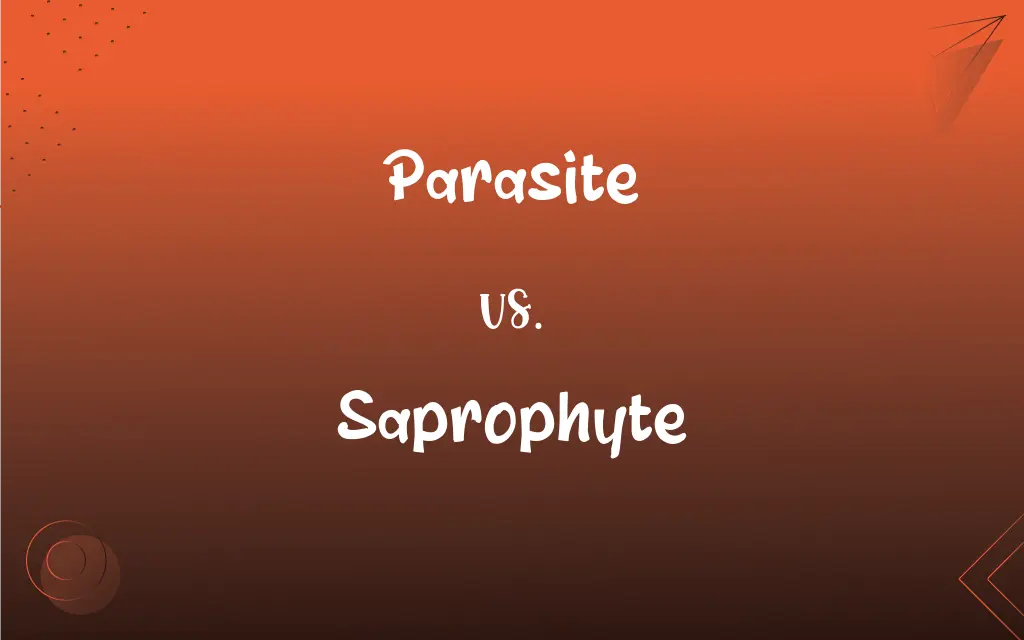Parasite vs. Saprophyte: What's the Difference?
Edited by Janet White || By Harlon Moss || Updated on October 14, 2023
A parasite derives nutrients by living on or in another organism, causing it harm, while a saprophyte obtains nutrients from decaying organic matter. Both are modes of nutrition among organisms.

Key Differences
Parasite and saprophyte both refer to organisms with specific strategies to obtain nutrients, but they do so in distinctly different manners. A parasite lives on or inside another organism, called the host, from which it extracts nutrients. In this relationship, the parasite benefits, often at the expense of the host, sometimes causing harm or disease. Examples include tapeworms in animals or mistletoe on trees.
Saprophytes, contrastingly, do not harm living organisms for their sustenance. Instead, they decompose and feed off dead organic matter. By doing so, saprophytes play a critical role in breaking down and recycling organic materials in ecosystems. Fungi and certain bacteria that break down fallen leaves in a forest are classic examples of saprophytes.
The lifestyles of parasites and saprophytes showcase the diversity in nature's approach to survival. While the parasitic mode might seem disadvantageous for the host, it offers the parasite a reliable source of nutrients. However, it becomes dependent on the host's survival. Saprophytes, conversely, rely on the abundance of decaying matter, ensuring a continuous food source, yet they don't risk depleting their resource base.
Interestingly, the distinction between a parasite and a saprophyte isn't always black and white. Some organisms can switch between these modes based on environmental conditions. But fundamentally, while parasites feed off living organisms, saprophytes benefit from the dead.
Comparison Chart
Source of Nutrients
Living organisms (hosts).
Dead or decaying organic matter.
ADVERTISEMENT
Impact on Source
Often harmful to the host.
No direct impact on living organisms.
Examples
Tapeworms, mistletoe.
Decomposing fungi, certain bacteria.
Dependency
Depends on the host's survival.
Relies on the availability of decaying matter.
Role in Ecosystem
Can cause diseases or imbalance.
Helps in recycling organic materials.
Parasite and Saprophyte Definitions
Parasite
An organism that benefits from another without reciprocating.
The cuckoo bird is a parasite, laying its eggs in other birds' nests.
ADVERTISEMENT
Saprophyte
An organism that feeds on decaying organic material.
Many mushrooms are saprophytes, thriving on dead wood.
Parasite
An entity that habitually relies on or exploits others.
Some view the relationship as parasitic, with one party benefiting more.
Saprophyte
An organism that plays a role in recycling organic matter.
Without saprophytes, dead plants would pile up, disrupting the ecosystem.
Parasite
An organism that can cause disease in its host.
Malaria is caused by a parasitic protozoan.
Saprophyte
An entity that benefits from situations without directly causing harm to others.
Some businesses act like saprophytes, capitalizing on the downfall of others.
Parasite
An organism that lives on or in a host and derives nutrients at the host's expense.
Ticks are parasites that feed on the blood of their hosts.
Saprophyte
A plant, fungus, or microorganism that decomposes dead organisms.
Saprophytes help in breaking down fallen leaves in the forest.
Parasite
A cause of harm or annoyance.
The software was infected with computer parasites.
Saprophyte
A non-parasitic organism obtaining its nutrients from non-living organic matter.
Many bacteria are saprophytes, vital for soil fertility.
Parasite
(Biology) An organism that lives and feeds on or in an organism of a different species and causes harm to its host.
Saprophyte
An organism, especially a fungus or bacterium, that derives its nourishment from dead or decaying organic matter. Also called saprobe.
Parasite
One who habitually takes advantage of the generosity of others without making any useful return.
Saprophyte
Any organism that lives on dead organic matter, as certain fungi and bacteria
Saprophyte
Any plant growing on decayed animal or vegetable matter, as most fungi and some flowering plants with no green color, as the Indian pipe.
Saprophyte
An organism that feeds on dead organic matter especially a fungus or bacterium
FAQs
What is parasitism?
Parasitism is a symbiotic relationship where the parasite benefits at the expense of the host.
What is a parasite?
A parasite is an organism that lives on or in a host organism and derives nutrients at the host's expense.
Can parasites be beneficial?
While typically harmful, some parasites can have inadvertent benefits, such as regulating host populations.
How are parasites transmitted?
Parasites can be transmitted through various means, including contaminated water, food, vectors, or direct contact.
Do parasites always harm the host?
Generally, yes. Parasites typically cause harm to their host, directly or indirectly.
How can parasitic infections be prevented?
Preventive measures include maintaining hygiene, using protective barriers, and in some cases, vaccination.
Do saprophytes photosynthesize?
No, saprophytes do not photosynthesize. They obtain nutrients from decaying matter.
What role do saprophytes play in ecosystems?
Saprophytes help decompose dead organisms, recycling nutrients back into ecosystems.
Are saprophytes parasites?
No, saprophytes feed on dead matter, while parasites derive nutrients from living hosts.
Do saprophytes need sunlight?
Saprophytes do not require sunlight for nutrition since they do not photosynthesize.
Can parasites infect humans?
Yes, parasites like tapeworms, lice, and malarial parasites can infect humans.
Are parasites animals?
Many parasites are animals (like worms and lice), but parasites can also belong to other biological kingdoms.
What is a saprophyte?
A saprophyte is an organism that feeds on dead organic matter, deriving its energy and nutrients.
Are saprophytes harmful?
Generally, no. Saprophytes are usually not harmful and play a crucial role in decomposing dead matter.
Can parasites be microscopic?
Yes, some parasites, like protozoa, are microscopic.
Can saprophytes be seen with the naked eye?
Some saprophytes, like certain fungi, can be seen without a microscope, while others cannot.
Are all parasites pathogens?
Most parasites are pathogens, but not all pathogens are parasites.
Are all fungi saprophytes?
While many fungi are saprophytic, not all fungi are saprophytes.
Can bacteria be saprophytic?
Yes, many bacteria are saprophytic, playing vital roles in decomposition.
Are saprophytes found in all ecosystems?
Yes, saprophytes are found in various ecosystems, aiding in decomposition processes.
About Author
Written by
Harlon MossHarlon is a seasoned quality moderator and accomplished content writer for Difference Wiki. An alumnus of the prestigious University of California, he earned his degree in Computer Science. Leveraging his academic background, Harlon brings a meticulous and informed perspective to his work, ensuring content accuracy and excellence.
Edited by
Janet WhiteJanet White has been an esteemed writer and blogger for Difference Wiki. Holding a Master's degree in Science and Medical Journalism from the prestigious Boston University, she has consistently demonstrated her expertise and passion for her field. When she's not immersed in her work, Janet relishes her time exercising, delving into a good book, and cherishing moments with friends and family.































































